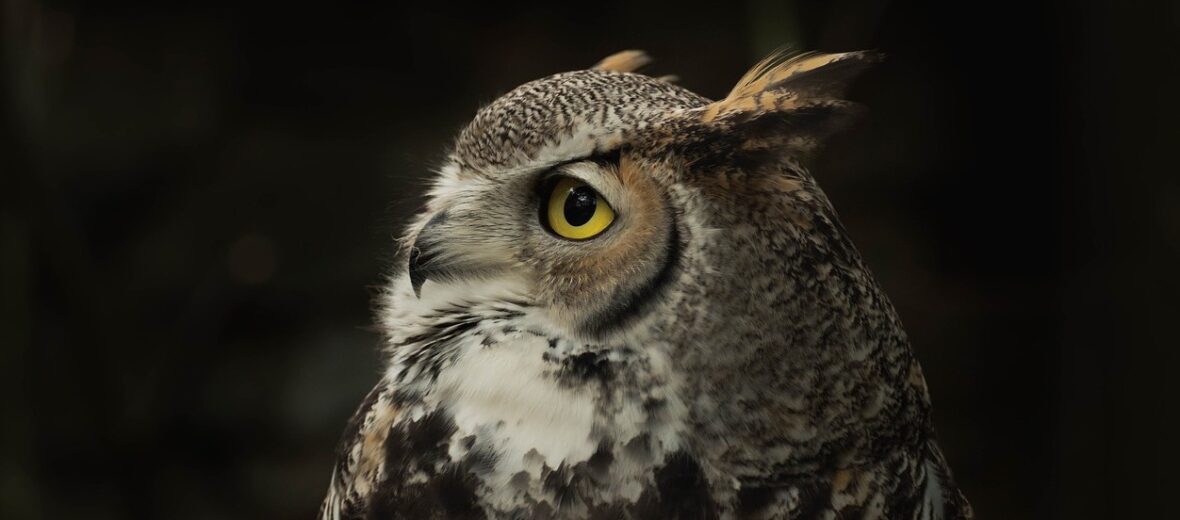
My favorite raptor has definitely got to be the owl. With huge eyes, silent flight, razor sharp talons, a swiveling head, and nocturnal (active at night) beauty? You just can’t go wrong. These birds of prey are fierce hunters that live in a variety of locations like rainforests, fields, deserts, and even the Arctic. I have written about many types of owls, such as the barn owl, snowy owl, northern spotted owl, and the great horned owl, just to name a few. Be sure to check out those articles.
First the Stats…
Scientific name: Strigiformes
Weight: Up to 5.9 lbs
Length: Up to 2.3 ft.
Wingspan: Up to 6 feet
Lifespan: Up to 15 years
Now on to the Facts!
1.) Owls can rotate their necks 270°. A blood-pooling system collects blood to power their brains and eyes when neck movement cuts off circulation.
2.) Their tube-shaped eyes are totally immobile, providing binocular vision which fully focuses on their prey and boosts depth perception. Because they can’t move their eyeballs, they have evolved the ability to swivel their heads, as previously mentioned.
3.) Owls are known to hunt other owls. Great Horned Owls are the top predator of the smaller Barred Owl.
4.) Barn Owls swallow their prey whole—skin, bones, and all—and they eat up to 1,000 mice per year.
5.) Many owl species have asymmetrical ears. They are also located at different heights on the owl’s head, their ears are able to pinpoint the location of sounds in multiple dimensions. Ready, aim, strike.
But wait, there’s more owl facts!
6.) Unlike most birds, owls make virtually no noise when they fly. They have special feathers that break turbulence into smaller currents, which reduces sound. Soft velvety down further muffles noise.
7.) The smallest owl in the world is the Elf Owl, which is merely 5 – 6 inches tall and weighs about 1.5 ounces. The largest North American owl, in appearance, is the great gray owl, which is up to 32 inches tall, with a 5 foot wingspan!
Did you know…?
A group of owls is called a parliament.
8.) Owl parents always feed the oldest and strongest owlet first. This means that if food is scarce, the youngest chicks will starve.
9.) Burrowing owls have been known to live in prairie dog burrows and also hunt with poop!
10.) Owls are nocturnal (active at night). That is when they hunt. This is one reason they have such large eyes.
But wait, there’s still more owl facts!
11.) They seldomly drink water. They get most of the hydration they need from their prey. It is rare to see an owl drinking water; however, you might see them taking a bath.
12.) These critters don’t chew their food, due to lacking teeth. This is why they swallow their prey whole and then vomit out the hair and feathers in what is known as a pellet.
13.) They are capable of making many different sounds. Owls are able to screech, hiss, and even growl! See, they don’t always just hoot.
14.) Sexual dimorphism exists in these birds. This means that the females are larger and more aggressive, I might add, than the males.
15.) The largest owls are the Eurasian eagle-owl and the Blakiston’s fish owl (Bubo blakistoni), they can reach weight of around 10 lbs. and have a wingspan of up to 6.6 feet!
Now a Short Video!
Also, check out the Critter Science YouTube channel. Videos added frequently!
Want to suggest a critter for me to write about? Let me know here.




Leave a Reply